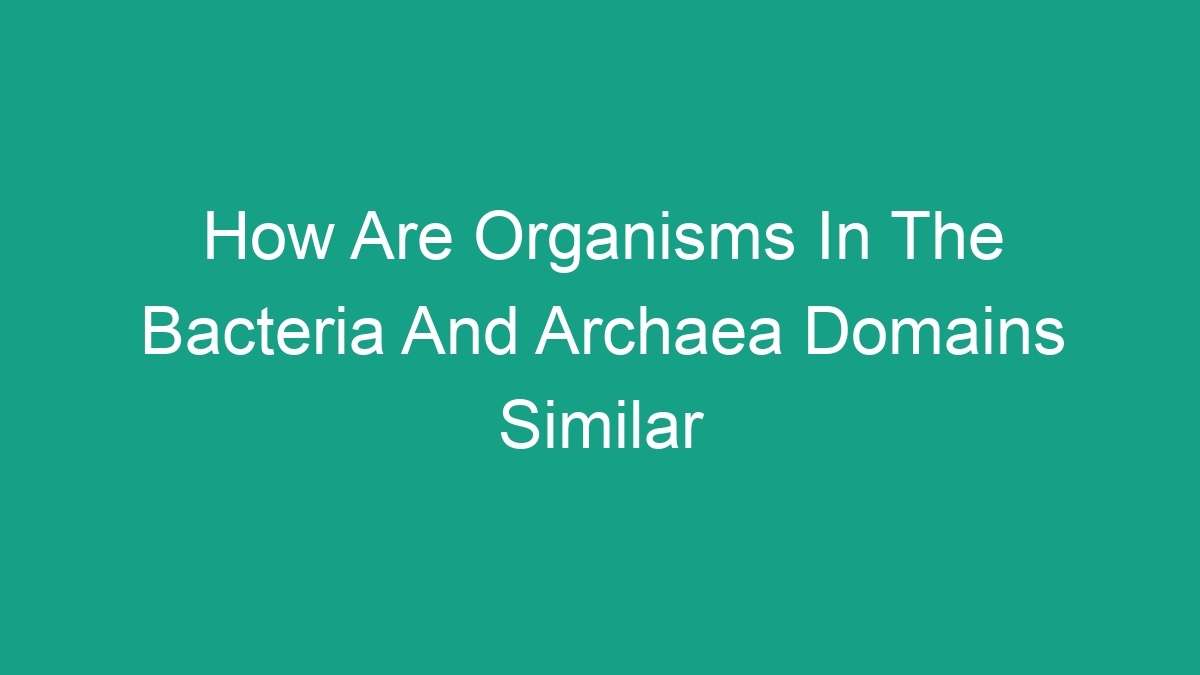
When discussing the diversity of life on Earth, two domains of organisms that often come to mind are Bacteria and Archaea. While these two domains may be distinct from each other, they also share a number of similarities. In this article, we will explore how organisms in the Bacteria and Archaea domains are similar and what sets them apart.
Understanding Bacteria and Archaea
Before we delve into their similarities, it’s important to understand what Bacteria and Archaea are. Both Bacteria and Archaea are prokaryotic organisms, meaning they lack a cell nucleus and membrane-bound organelles. They are considered to be the simplest and most ancient forms of life on Earth, with origins dating back billions of years.
Bacteria: The domain Bacteria encompasses a diverse group of microorganisms that can be found in nearly every environment on Earth. From soil to oceans, and from inside the human body to extreme environments such as hot springs and deep-sea hydrothermal vents, bacteria have adapted to thrive in a wide range of conditions.
Archaea: Archaea, on the other hand, are also single-celled microorganisms that can be found in various environments. Initially, archaea were thought to exist only in extreme environments, such as hot springs and salt lakes, leading to the misconception that they were “extremophiles.” However, it is now known that archaea are also present in more moderate environments, including the human gut.
Similarities Between Bacteria and Archaea
Despite their differences, Bacteria and Archaea share several key similarities:
1. Cell Structure: Both Bacteria and Archaea are prokaryotic organisms, meaning they lack a true nucleus and other membrane-bound organelles. Their genetic material is contained within a single circular chromosome located in the cytoplasm.
2. Cell Size and Shape: Both domains consist of cells that are typically smaller and simpler in structure compared to eukaryotic cells. They come in a variety of shapes, including spheres (cocci), rod-shaped (bacilli), and spiral-shaped (spirilla).
3. Metabolism: Bacteria and Archaea can obtain energy through a variety of metabolic pathways. They can be autotrophs, producing their own energy through processes such as photosynthesis, or heterotrophs, relying on external sources of organic compounds for their energy needs.
4. Reproduction: Both Bacteria and Archaea reproduce asexually through binary fission, in which a single cell divides into two identical daughter cells. This process allows them to multiply rapidly under favorable conditions.
5. Genetic Material: The genetic material of both Bacteria and Archaea is composed of DNA, and they share a similar genetic code for protein synthesis. However, certain differences in their genetic machinery set them apart from each other and from eukaryotic organisms.
Differences Between Bacteria and Archaea
While Bacteria and Archaea share several similarities, they also exhibit distinct differences:
1. Cell Wall Composition: One of the most significant differences between Bacteria and Archaea is the composition of their cell walls. Bacterial cell walls contain peptidoglycan, a polymer made of sugar and amino acids, while archaeal cell walls lack peptidoglycan and are composed of other substances such as pseudopeptidoglycan or protein.
2. Membrane Lipids: The lipid molecules that make up the cell membranes of Bacteria and Archaea are also different. Bacterial membranes contain ester-linked lipids, while archaeal membranes contain ether-linked lipids. This distinction is one of the factors that sets Archaea apart from Bacteria.
3. Environmental Adaptation: While both domains can be found in a wide range of environments, Archaea are known to thrive in extreme conditions, such as high temperature, high acidity, or high salinity. Many archaea are extremophiles, capable of surviving and thriving in environments that would be lethal to most other organisms.
4. Ribosomal Structure: The ribosomes of Bacteria and Archaea, while similar, have unique structural differences that set them apart from each other. These differences have implications for the translation of genetic information into proteins, and they contribute to the distinctiveness of the two domains.
5. Metabolic Pathways: While both Bacteria and Archaea have diverse metabolic capabilities, they employ different biochemical pathways for energy production and nutrient processing. For example, Archaea are known to use methanogenesis, a unique metabolic pathway for producing methane as a byproduct.
Conclusion
In conclusion, Bacteria and Archaea share many fundamental characteristics due to their status as prokaryotic organisms. These similarities include their cell structure, size and shape, metabolism, reproduction, and genetic material. However, they also exhibit key differences, such as their cell wall composition, membrane lipids, environmental adaptation, ribosomal structure, and metabolic pathways.
Understanding the similarities and differences between Bacteria and Archaea is essential for gaining insight into the diversity of life on Earth and the evolutionary history of these ancient organisms. As scientific research continues to uncover new information about these domains, it becomes increasingly clear that Bacteria and Archaea are not only important in their own right but also serve as valuable models for understanding the fundamental principles of life.



